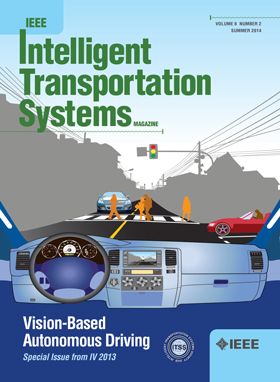Differential Image-Based Scalable YOLOv7-Tiny Implementation for Clustered Embedded Systems
IF 7.9
1区 工程技术
Q1 ENGINEERING, CIVIL
IEEE Transactions on Intelligent Transportation Systems
Pub Date : 2024-10-09
DOI:10.1109/TITS.2024.3419095
引用次数: 0
Abstract
Convolutional neural networks (CNNs) for powerful visual image analysis are gaining popularity in artificial intelligence. The main difference in CNNs compared to other artificial neural networks is that many convolutional layers are added, which improve the performance of visual image analysis by extracting the feature maps required for image classification. However, algorithm optimization is required to run applications that require low-latency in edge compute modules with limited processing resources. In this paper, we propose a novel algorithm optimization method for fast CNNs by using continuous differential images. The main idea is to reduce computation variably by using the differential value of the input in each convolutional layer. Also, the proposed method is compatible with all types of CNNs, and the performance is better when the pixel value difference of continuous images is low. We use the DarkNet framework to evaluate our algorithm using fast convolution and half convolution approaches on a clustered system. As a result, when the input frame rate is 10 fps, FLOPs are reduced by about 4.92 times compared to the original YOLOv7-tiny. By reducing the FLOPs of the convolutional layer, the inference speed increases to about 4.86 FPS, performing 1.57 times faster than the original YOLOv7-tiny. In the case of parallel processing that used two edge compute modules for using half convolution approach, FLOPs reduced more, and the response speed improved. In addition, faster Object detection implementation is possible by additionally expanding up to 7 compute modules in a scalable clustered embedded system as much as the user wants.用于集群嵌入式系统的基于差分图像的可扩展 YOLOv7-Tiny 实现
用于强大视觉图像分析的卷积神经网络(CNN)在人工智能领域越来越受欢迎。与其他人工神经网络相比,卷积神经网络的主要区别在于增加了许多卷积层,通过提取图像分类所需的特征图,提高了视觉图像分析的性能。然而,要在处理资源有限的边缘计算模块中运行要求低延迟的应用,就需要对算法进行优化。在本文中,我们利用连续差分图像为快速 CNN 提出了一种新的算法优化方法。其主要思想是通过在每个卷积层中使用输入的差分值来可变地减少计算量。此外,所提出的方法与所有类型的 CNN 都兼容,而且当连续图像的像素值差值较低时,其性能会更好。我们使用 DarkNet 框架,在聚类系统上使用快速卷积和半卷积方法评估我们的算法。结果显示,当输入帧速率为 10 fps 时,FLOPs 与原始 YOLOv7-tiny 相比减少了约 4.92 倍。通过减少卷积层的 FLOPs,推理速度提高到约 4.86 FPS,比原来的 YOLOv7-tiny 快 1.57 倍。在使用两个边缘计算模块进行半卷积并行处理的情况下,FLOPs 减少得更多,响应速度也有所提高。此外,通过在可扩展的集群嵌入式系统中根据用户需要额外扩展多达 7 个计算模块,可以实现更快的对象检测。
本文章由计算机程序翻译,如有差异,请以英文原文为准。
求助全文
约1分钟内获得全文
求助全文
来源期刊

IEEE Transactions on Intelligent Transportation Systems
工程技术-工程:电子与电气
CiteScore
14.80
自引率
12.90%
发文量
1872
审稿时长
7.5 months
期刊介绍:
The theoretical, experimental and operational aspects of electrical and electronics engineering and information technologies as applied to Intelligent Transportation Systems (ITS). Intelligent Transportation Systems are defined as those systems utilizing synergistic technologies and systems engineering concepts to develop and improve transportation systems of all kinds. The scope of this interdisciplinary activity includes the promotion, consolidation and coordination of ITS technical activities among IEEE entities, and providing a focus for cooperative activities, both internally and externally.
 求助内容:
求助内容: 应助结果提醒方式:
应助结果提醒方式:


